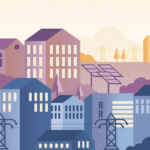EPV POWER
The business area of EPV Power includes the generation of hydropower and nuclear power by the companies Pohjolan Voima, Teollisuuden Voima, Voimapiha and Rapid Power.
The EPV Power business area had a good electricity generation year in 2019. Electricity production in Olkiluoto nuclear power units 1 and 2 was at its peak and achieved the historical production level of 500 terawatts. The commissioning of Olkiluoto unit 3 was once again delayed. Hydroelectric power reached average production figures. Manga LNG import terminal was put into commercial operation in the autumn of 2019.
EPV’s associated company Teollisuuden Voima (TVO) reached record figures in its nuclear power generation. Olkiluoto unit 1 had the best production year in its entire history, and units 1 and 2 combined had their second best production year ever. The units were run at full capacity without major interruptions.
“The record production is the result of the TVO nuclear power stations’ methodical life cycle management, proactive maintenance strategy and carefully planned annual outage,” says Niko Paaso, Director of the EPV Power business area.
The annual outages of Olkiluoto units 1 and 2 took 6 weeks and were completed in June 2019. Olkiluoto unit 2 had more major maintenance work carried out, resulting in a slightly longer shutdown. The work included:
- refuelling
- successful pressure test of the primary circuit
- renewal of the heat exchanger in the reactor water purification system
- renewal of the 400 kV switchgear
Support for nuclear power at a historical high
Olkiluoto nuclear power plants achieved the historical milestone of 500 terawatt hours produced. This is an enormous volume of electricity free from carbon dioxide. If an equivalent volume of electricity had been produced with coal instead of nuclear power, it would have resulted in approximately 400 million tonnes of carbon dioxide emissions. For the sake of comparison, the carbon dioxide emissions of Finland as a whole in 2019 were 5.5 million tonnes. According to Paaso, a survey by Finnish Energy shows that support for nuclear power has grown significantly. One noteworthy reason for this growth is presumably the increased anxiety about the climate.
Finnish Energy carried out a survey on the support of various methods of energy generation in April 2019. The results show that support for nuclear power is at a record high. Almost half of the respondents, 49%, viewed nuclear power positively, while only 15% had a negative view. This means that the support is higher than ever in the history of measuring it.
The schedule for Olkiluoto unit 3 was updated twice
The schedule for the Olkiluoto 3 nuclear power plant has been updated. According to the plant supplier’s most recent estimated timetable:
- nuclear fuel will be loaded into the reactor in June 2020
- the power plant will be connected to the national grid in November 2020
- regular electricity production will begin in March 2021
The delay is unfortunate, but what is most important is to have in use a modern and safe nuclear power plant.
The foundation stone for the Posiva encapsulation plant has been laid
Posiva is an expert organisation in nuclear waste management and responsible for the final disposal of the spent nuclear fuel of its owners, Teollisuuden Voima and Fortum, as well as the final disposal studies concerning their spent nuclear fuel, the construction and operation of their final disposal facility and the closure of the facility after use.
Posiva’s final disposal project for spent nuclear fuel achieved a significant staging post when the company’s Board of Directors decided to realise an encapsulation plant and an underground final disposal facility. The encapsulation plant’s foundation stone was laid in September 2019. The preparations for the final disposal have been carried out methodically for almost 40 years.
The production volume of hydropower in 2019 was equivalent to its historical average
EPV Energy holds hydropower shares in Finland through PVO-Vesivoima, in Sweden through Voimapiha and in Norway through Rapid Power. PVO-Vesivoima and Voimapiha’s production volumes of hydropower were equivalent to their historical average.
“Voimapiha’s hydroelectric power plants saw some extensive maintenance work, which caused slight unavailability for them. However, all the machinery was in operation by the end of the year,” Paaso says.
Rapid Power’s production volume was lower than average. Rapid Power’s hydroelectric power production in Norway has been based on a 15-year leasing contract on the Rana hydroelectric power station. The leasing contract expired at the end of 2019. Preparations were made throughout the year for the expiry of the contract.
According to Paaso, producers of electricity are worried about the flexibility of the electricity system as wind power construction increases and the production capacity for dispatchable condensing power is taken off the market.
“Hydropower is an excellent emission-free solution to this challenge and its importance for the electricity system has increased further.”
Solutions are being sought to fix the lack of capacity
As far as the energy market’s operating reserve is concerned, no significant changes or developments have occurred. No individual solutions to the problem have entered the market. New methods of electricity generation capable of adjustability, as well as new energy storage methods and possibilities for consumption flexibility and their forms are still being sought.
“We are constantly seeking and researching alternatives for increasing the production of adjustable electricity. Solutions are also needed for increasing flexibility in the existing production capacity. In addition, we are seeking ways to make our current power plants more flexible,” Niko Paaso explains.



